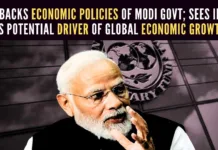
Facts speak loud and clear
Freedom to practice one’s religion or belief is everyone’s fundamental right irrespective of geography. We focus on India’s religious freedom or lack thereof as wrongfully narrated in the annual reports by the U.S. Department of State on International Religious Freedom (IRF) and the US Commission on International Religious Freedom (USCIRF)[1][2]. We only discuss the IRF report and leave the question of why the USCIRF report in a subsequent article.
Our questions include why the two entities of the U.S. government are monitoring religious freedom around the world but itself? We wonder if the reports just clutter the physical and/ or digital space; do the reports engage countries toward reform, are the reports worth the expense and effort yielding any tangible diplomatic outcomes, and are the punitive sanctions imposed by the U.S. affecting any societal changes for the better? In my view, none of the answers are affirmative. Thus, the reports point to more of the U.S.’s Dadagiri, i.e., the intimidation and/ or bullying of countries who perhaps don’t care and are wrongfully accused.
According to the Preface of 2020 IRF[3], “Across the globe, in far too many places, individuals continue to be killed, tortured, jailed, harassed, and threatened on account of their religious identity or beliefs.” This is the bitter truth and we must own it globally. I go a step further that such incidences must be condemned and lawfully dealt with even for other reasons like racial and gender bias, politically motivated actions, and economic inequalities. The U.S. is not immune to unwarranted killing, torture, and harassment of individuals due to many different biases including religious intolerance. Who monitors the U.S. and why not?
In India’s context, we observe that such incidences are far fewer than the U.S. watchdog agencies, and often the Western media, make of it. The left-wing media and politically motivated federal agencies make a mountain out of a mole because they are very selective in what they want to read and report. The analysis of IRF and USCRIF reports about India since 2019 categorically cite a handful of policies, practices, and events that, in their subjective judgment are discriminatory based on religious differences. These include the parliamentary enactment of CAA (Citizenship Amendment Act), court-directed NRC, abrogation of Article 370 in Kashmir, and tightening of FCRA (Foreign Currency Regulations Act) to monitor the flow of foreign exchange for purposes like religious conversion and promoting anti-national sectarian and separatism. The victim in interfaith marriages (dubbed love-jihad) based on deception and ending in death, divorce, and/ or forced religious conversion is almost always a Hindu girl at the hands of a Muslim man.
The IRF and USCIRF narratives use only one lens of characterizing incidences as the ‘majority (Hindu) against the minority religions (particularly Muslims) which is far from the truth. For example, the infamous Shaheen Bagh protests against NRC/ CAA in 2019 and the following riots in Delhi were led by the select members of minority religious leaders and those believing in the separatist movement. To the best of my knowledge, not even one Muslim born and living in India lost nationality because of NRC/ CAA. The riots indeed caused significant loss of property and even deaths among both religious communities. However, the narratives excluded how the public spaces and roads were blocked for months causing severe inconveniences to children going to school and people going to work.
The IRF report fails to highlight the facts such as Kashmir (post-Article 370) is no longer a hotbed of innocent killings, torture, and terrorist activities by insurgents crossing across the border. The changing environment of development, cultural renaissance, and equality for all in Kashmir valley are taking roots steadily. With respect to FCRA, what is wrong if all NGOs follow the laws of the land. A more detailed analysis of the 2022 USCRIF report not being credible is available elsewhere[4].
Let us analyze India according to the statement in 2020 IRF by none other than Secretary of State Blinken[3], “Governments that effectively safeguard religious freedom are more stable, more economically vibrant, and more peaceful.” India has been a politically stable democracy for 75 years since independence. India’s economic development and GDP are on the rise and are projected to become the third-highest economy by 2031. The social cohesion among people of different faiths is very good, if not the best, considering its religious plurality, population, and proximity to nations harboring hostilities and terrorism and thus threatening India’s national security.
These facts speak loud and clear that India is capable and effective in safeguarding religious freedom without outside intervention and advice. India is among the countries with no significant lawlessness. In addition, India addresses religious freedom issues on an ongoing basis as provided in the constitution and/ or defensible in the court of law.
India has rightfully stood firm in its foreign policy resolve not to side with the U.S. in the Ukraine-Russia conflict. Consequently, fearless India may face recrimination, trade sanctions, and other actions jeopardizing the natural alliance between the world’s largest and oldest democracies. The expanding bilateral US-India Strategic Partnership Forum (USISPF) is also likely to be impacted[5]. Let us hope, however, that the diplomatic wisdom will prevail not to let India and U.S. in each other’s crosshairs.
While India today is at a crossroads, its political stability, rising economy, relative peace, and social cohesion are strong testimony of its resiliency, strength, character, and values. India like other countries may never be fully-proof against people agitating on account of perceived or real religious identity or belief but India’s centuries-old history of survival and coexistence with people of all faith are deserving of respect and recognition.
The U.S. may wish to monitor religious freedom in India and across the world but not without looking inward. It will be better if the U.S. is more factual and less judgmental. Let the U.S. State Department use its diplomatic prowess to focus less on religious freedom and more on expanding people-to-people goodwill and collaboration in critical areas of global importance.
The U.S. was once the “Superpower’ but today it has diminishing influence and role in geopolitical issues and the world economy. India, an impoverished and struggling economy in the past, is a fast-growing economy and strategically significant player in the geopolitical hedge in countering China’s ambitions expansionist dreams. Why then the U.S. is making attempts of Dadagiri toward India?
Note:
1. Text in Blue points to additional data on the topic.
2. The views expressed here are those of the author and do not necessarily represent or reflect the views of PGurus.
Reference:
[1] International Religious Freedom Reports – U.S. Dept of State
[2] Annual Reports – USCIRF
[3] 2020 Report on International Religious Freedom – May 12, 2021, U.S. Dept of State
[4] USCIRF Report is Not Credible – May 18, 2022, Daily Pioneer
[5] US-India Strategic Partnership Forum – USISPf
PGurus is now on Telegram. Click here to join our channel and stay updated with all the latest news and views
For all the latest updates, download PGurus App.
- Education and election in Bharat: Race to the top - April 16, 2024
- Kejriwal: “An Insignificant Man” or a corrupt politician with impending prison term - March 24, 2024
- Bharat’s general elections and the Model Code of Conduct - March 22, 2024










